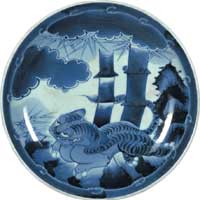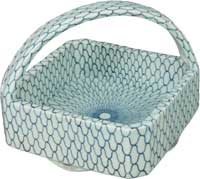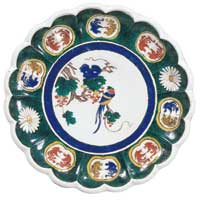The Toguri Museum of Art:
Exhibition Schedule for April 2019 – March 2020
◇April 6 – June 20, 2019
Exploring the Ceramics of Saga and Nagasaki
 The part of Kyushu that is now Saga Prefecture and a portion of Nagasaki Prefecture was known during the Edo period as the province of Hizen. It was a famous area for ceramics. While there was no significant production before the middle ages, the situation changed suddenly at the end the 16th century. Ceramic artisans came to Japan from the Korean peninsula and set up kilns, beginning with the production of earthenware pottery known as Karatsu ware because it was produced in and around Karatsu, in what is now Saga Prefecture. Very soon, the technology spread all over northern Kyushu. A notable example is the town of Takeo, also in Saga Prefecture; the earthenware pottery made there during the Edo period is now known as Ko-Dakeo, meaning old Takeo ware. This sort of earthenware was also made in Arita, which was then part of the Saga Nabeshima domain, and it was in Arita, in the early 17th century, that potters succeeded in making the first domestic porcelain in Japan. It was called Imari ware, taking its name from the port from which it was shipped. Boasting colorful decorations on a beautiful white porcelain base, Imari ware quickly gained favor in both Japan and overseas. Porcelain operations spread beyond Arita to neighboring towns, including Takeo and Ureshino, allowing for large volumes of porcelain production. Later, in the second half of the 17th century, the Saga Nabeshima domain built upon the technology of Imari ware to begin production of a particularly fine and beautiful type of porcelain known as Nabeshima ware, intended as gifts of tribute to the Tokugawa Shogunate. Soon after the emergence of Japan’s first domestic porcelain in Arita, porcelain production also began in what is now Nagasaki Prefecture, in Hasami, then part of the Omura domain, and Mikawachi, then part of the Hirado domain. Thus, it was within a very brief span of time that the province of Hizen emerged as a major force in porcelain production, a legacy that continues to this very day.
The part of Kyushu that is now Saga Prefecture and a portion of Nagasaki Prefecture was known during the Edo period as the province of Hizen. It was a famous area for ceramics. While there was no significant production before the middle ages, the situation changed suddenly at the end the 16th century. Ceramic artisans came to Japan from the Korean peninsula and set up kilns, beginning with the production of earthenware pottery known as Karatsu ware because it was produced in and around Karatsu, in what is now Saga Prefecture. Very soon, the technology spread all over northern Kyushu. A notable example is the town of Takeo, also in Saga Prefecture; the earthenware pottery made there during the Edo period is now known as Ko-Dakeo, meaning old Takeo ware. This sort of earthenware was also made in Arita, which was then part of the Saga Nabeshima domain, and it was in Arita, in the early 17th century, that potters succeeded in making the first domestic porcelain in Japan. It was called Imari ware, taking its name from the port from which it was shipped. Boasting colorful decorations on a beautiful white porcelain base, Imari ware quickly gained favor in both Japan and overseas. Porcelain operations spread beyond Arita to neighboring towns, including Takeo and Ureshino, allowing for large volumes of porcelain production. Later, in the second half of the 17th century, the Saga Nabeshima domain built upon the technology of Imari ware to begin production of a particularly fine and beautiful type of porcelain known as Nabeshima ware, intended as gifts of tribute to the Tokugawa Shogunate. Soon after the emergence of Japan’s first domestic porcelain in Arita, porcelain production also began in what is now Nagasaki Prefecture, in Hasami, then part of the Omura domain, and Mikawachi, then part of the Hirado domain. Thus, it was within a very brief span of time that the province of Hizen emerged as a major force in porcelain production, a legacy that continues to this very day. In this exhibition, we bring together from our collection a special selection of Edo-era Imari ware and modern-day Arita products, along with stunning examples of Ko-Dakeo and Nabeshima and Shida ware and ceramics from Hasami and Mikawachi. We hope you will enjoy this opportunity to tour, all at one time, the rich variety in this region’s ceramics.
<Dish, decorated with tiger and bamboo design in underglaze blue. Shida ware. Edo period. The first half of the 19th century.>
◇July 2 – Sept. 22, 2019
‘Edo Blue’ in Imari Ware (in cooperation with the Ota Memorial Museum of Art)
 In Japan, dyeing technology advanced rapidly during the Edo period, and indigo dying, in particular, spread among the common people. Beautiful blues in all sorts of shades became available, known by names such as asagi, hanada and koi-ai. It was also during the Edo period that a significant ceramic industry developed in Arita, in what is now Saga Prefecture, where potters succeeded in producing Japan’s first domestic porcelain. This was known as Imari ware, taking its name from the port from which it was shipped. One of the main product lines was a type of blue-and-white ceramics called sometsuke, made by coating the white porcelain base with a clear glaze and applying designs in a softly blurred blue. The very name sometsuke is a reference to indigo dying, as it means “to dye.” New forms of expression in sometsuke developed constantly, keeping pace with changes in tastes and fashions in blue.
In Japan, dyeing technology advanced rapidly during the Edo period, and indigo dying, in particular, spread among the common people. Beautiful blues in all sorts of shades became available, known by names such as asagi, hanada and koi-ai. It was also during the Edo period that a significant ceramic industry developed in Arita, in what is now Saga Prefecture, where potters succeeded in producing Japan’s first domestic porcelain. This was known as Imari ware, taking its name from the port from which it was shipped. One of the main product lines was a type of blue-and-white ceramics called sometsuke, made by coating the white porcelain base with a clear glaze and applying designs in a softly blurred blue. The very name sometsuke is a reference to indigo dying, as it means “to dye.” New forms of expression in sometsuke developed constantly, keeping pace with changes in tastes and fashions in blue.
Imari ware followed trends carefully, picking up new ideas and fashions and incorporating them into products. One particularly important development occurred in the early 18th century, when the kilns moved into larger-scale production of blue-and-white dishes in response to market expansion and the flourishing of food culture. Around the same time, the Arita kilns also began to make porcelain versions of everyday products that until then had been made of metal or wood, such as the hand pulls for sliding doors and playing pieces for the game of shogi. As a result, Imari ware sometsuke came to contribute an even bigger part of the blue that brightened the lives of people during the Edo period.
This exhibition is organized in cooperation with the Ota Memorial Museum of Art, which specializes in ukiyoe woodblock prints and is holding a concurrent exhibition on the same theme. Under the shared title of “Edo Blue,” each museum will draw on its own collection to show how the color blue was a vibrant part of the lives of people during the Edo period. At the Toguri Museum of Art, we will present a gorgeous selection of Imari ware in the beautiful blues that have come to symbolize the Edo era and lifestyle.
<Bowl with bridge handle, decorated with net pattern design in underglaze blue. Imari ware. Edo period. The second half of the 18th century.>
◇October 4 – December 19, 2019
Fascinating Shapes in Ko-Imari - I
◇January 7 – March 22, 2020
Fascinating Shapes in Ko-Imari - II
 Round and square. Shaped like flowers, leaves, gourds, birds, rabbits, hats and fans. Long, thin necks. Broadly rounded bodies. These are all forms seen in Imari ware, Japan’s first domestic porcelain, which arose at the beginning of the 17th century in Arita, in what is now Saga Prefecture. Imari ware made during the Edo period is generally referred to as Ko-Imari.
Round and square. Shaped like flowers, leaves, gourds, birds, rabbits, hats and fans. Long, thin necks. Broadly rounded bodies. These are all forms seen in Imari ware, Japan’s first domestic porcelain, which arose at the beginning of the 17th century in Arita, in what is now Saga Prefecture. Imari ware made during the Edo period is generally referred to as Ko-Imari.
The kilns in Arita, which developed very rapidly into one of the world’s most important porcelain industries, created a great variety of products, adapting constantly to market demand. When the culture of tea ceremony was at its height during the first half of the 17th century, for example, the kilns in Arita produced mizusashi water jars and chaire tea caddies, as well as dishes and food cups suitable for the tasteful cha-kaiseki meals served to guests as part of tea culture. Arita also produced large dishes and sets that were used at the frequent banquets hosted by feudal lords.
In the second half of the 17th century, when exports to Europe flourished, potters learned to make new shapes such as tea pots, sugar bowls and wine goblets. And when the domestic market expanded from the 18th century, the Arita kilns moved into larger-scale production of sets of dishes and bowls, and even began to manufacture porcelain versions of common items for everyday use, such as handwarmers and trays for tobacco sets. Consumers delighted in this playfulness, and through these colorful substitutes Imari ware came to further brighten everyday life.
While many different forms emerged in accordance with function, there were also many shapes that served as part of decoration. By moving beyond building on wheels to the use of molds, many innovative new shapes became possible, often combined with other decorative elements such as painted and incised patterns.
Presented in two parts, this exhibition explores the great variety of shapes seen in Ko-Imari, approaching the subject from different angles including function, decorative design and the various techniques mused to build a form.
<Dish with foliated rim, decorated with bird and grapevine design in underglaze blue and overglaze enamels. Imari ware in Ko-Kutani style. Edo period. Mid-17th century.>
.jpg)




